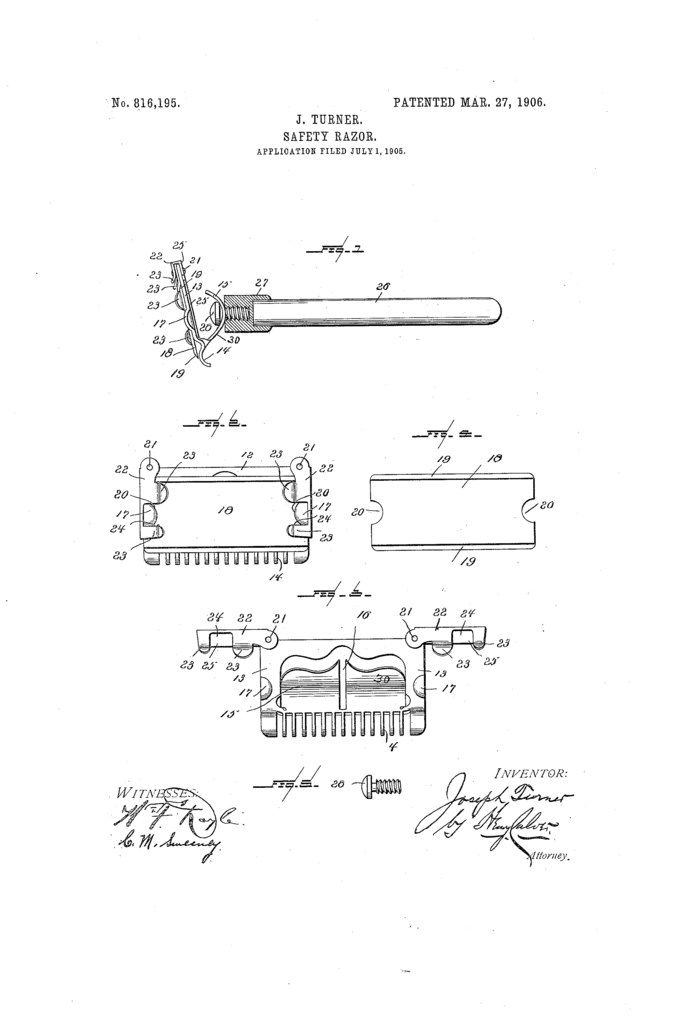Joseph Turner did what many others did around the turn of the last century; he invented a safety razor. A safety razor that was, according to the patent, easily manufactured, as well as efficient and convenient in use. It is also a very workmanlike1 razor to my eye. And I believe a similar razor could be manufactured today, possible for the GEM blades.
The hearth of any safety razor is it’s blade. And to extend the metaphor, the rib cage of the razors is its head.
Okay, perhaps I extended the metaphor too far… but the point is, the head is there to hold and guide the blade, and the design of the head factors in greatly when it comes to the quality of the shave. And the head that Joseph Turner came up with is different from the razors we use today. Lets look at the patent text and drawing before I try to break it down.
The patent
…the frame or blade-holder is preferably formed from a single piece of sheet metal and comprises in the construction herein shown the top bar 12, the side bars 13, the comb or guard 14, and the curved back-plate 15, provided with the slot 16. The side bars 13 are provided on their front faces with blade-holding projections or lugs 17, preferably struck up from the sheet metal, and the curved back-plate 15 is also struck out from the piece of sheet metal forming the frame and is thus integral with the other parts of the frame. The thin but practically rigid steel blade 18 is preferably provided with two longitudinal cutting edges 19 and is constructed at its ends with central notches 20 of proper shape and form to receive the projections or lugs 17 on the frame or blade-holder, so that when the blade is placed in position with said lugs registering with said notches a cutting edge of the blade will be in proper position relative to the guard or comb 14.
Joseph Turner, in US patent 816,195
Pivotally attached by rivets 21 to the upper corners of the frame or blade-holder are swinging clamps or catches 22, each of which is preferably provided with two fingers 23, between which is a notch 24 to register with a blade-holding projection 17, each of the said clamps having a lip or flange 25 opposite the said fingers to engage the rear side of the blade-holder and between which flanges and fingers is an opening of suitable width to receive a side bar 13 and an end of the blade 18.

Quick and dirty analysis
As can be seen from the drawing and the text, the head – or frame holder, as the patent refers to it – is made from a stamped and folded piece of sheet metal. The centre piece is partly cut out and folded down. On both sides there are raised lugs. The back of the head is folded up and around to provide a backstop,2 as well as a mounting point for the two swinging clamps that holds the blade in place.
The blade, as drawn, is a double edged design. Even so, only one edge was presented to the shaver. On the upside, this mean that a blade will last twice as long. On the downside, this means one edge will be exposed to humidity and air long before it meets the stubble.
The way it was supposed to work, best I can figure out, is that the two lugs (17) in the head would mate with the cutouts on the blade. This would locate the blade so it could not move side to side or up and down. The two clamps would then swing into place, pressing the blade down against the holder. A slightly fiddly way to do it perhaps, but simple to make.
As an added bonus, the slot cut in the back-plate made shaving angle adjustable. Just loosen the screw, tilt the head to the desired angle, and tighten it again. Nice, simple, and something I’ve not seen on any production razor.
Final thoughts
I’ve have found no indication that the razor was ever manufactured. Likely this was because it required a proprietary blade. Setting up a system for blade manufacture and distribution would require a lot more in the way of logistics than the razors themselves. However, I see no reason why design would not work with a Gem blade. The only thing needed is someone willing to adjust the design of the frame holder to accept the spine. Oh, and willing to fund production… that might be a stumbling block.
As usual, the full patent as filed by Joseph Turner can be read at Google Patents, as well as at razors.click. If you enjoy this sort of thing, I got a lot of shaving patents and other oddities on my blog.
Footnotes
- Workmanlike; showing an acceptable level of skill but no great ability or style.
- Which would also protect the second edge from the shavers fingers… or vice versa.
